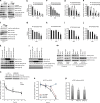MNKs act as a regulatory switch for eIF4E1 and eIF4E3 driven mRNA translation in DLBCL
- PMID: 25403230
- PMCID: PMC4238046
- DOI: 10.1038/ncomms6413
MNKs act as a regulatory switch for eIF4E1 and eIF4E3 driven mRNA translation in DLBCL
Abstract
The phosphorylation of eIF4E1 at serine 209 by MNK1 or MNK2 has been shown to initiate oncogenic mRNA translation, a process that favours cancer development and maintenance. Here, we interrogate the MNK-eIF4E axis in diffuse large B-cell lymphoma (DLBCL) and show a distinct distribution of MNK1 and MNK2 in germinal centre B-cell (GCB) and activated B-cell (ABC) DLBCL. Despite displaying a differential distribution in GCB and ABC, both MNKs functionally complement each other to sustain cell survival. MNK inhibition ablates eIF4E1 phosphorylation and concurrently enhances eIF4E3 expression. Loss of MNK protein itself downregulates total eIF4E1 protein level by reducing eIF4E1 mRNA polysomal loading without affecting total mRNA level or stability. Enhanced eIF4E3 expression marginally suppresses eIF4E1-driven translation but exhibits a unique translatome that unveils a novel role for eIF4E3 in translation initiation. We propose that MNKs can modulate oncogenic translation by regulating eIF4E1-eIF4E3 levels and activity in DLBCL.
Figures








References
-
- Ruggero D. et al. The translation factor eIF-4E promotes tumor formation and cooperates with c-myc in lymphomagenesis. Nat. Med. 10, 484–486 (2004). - PubMed
-
- Gingras A. C., Raught B. & Sonenberg N. eIF4 initiation factors: Effectors of mRNA recruitment to ribosomes and regulators of translation. Annu. Rev. Biochem. 68, 913–963 (1999). - PubMed
Publication types
MeSH terms
Substances
Associated data
- Actions
Grants and funding
LinkOut - more resources
Full Text Sources
Other Literature Sources
Molecular Biology Databases
Research Materials

